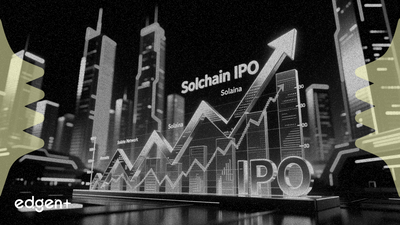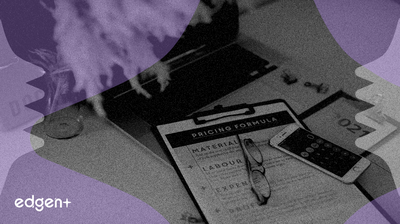
No Data Yet
Noticias relacionadas

Interactive Brokers Adopta Stablecoins, Presionando a sus Rivales
## Resumen Ejecutivo Interactive Brokers ha anunciado que ahora aceptará stablecoins para la financiación de cuentas de inversores minoristas. Esta decisión representa un movimiento estratégico para mantener la competitividad a medida que la industria de servicios financieros integra cada vez más activos digitales. La función se introducirá a través de un despliegue gradual, comenzando con una parte de la base de clientes estadounidenses elegibles de la firma. La iniciativa señala un paso significativo para cerrar la brecha entre los mercados financieros tradicionales y el ecosistema de las monedas digitales. ## El Evento en Detalle Según el anuncio, los inversores minoristas de **Interactive Brokers** tendrán la capacidad de depositar stablecoins directamente en sus cuentas de trading. Esta iniciativa está diseñada para mejorar la eficiencia y la velocidad de la financiación en comparación con los métodos tradicionales. La firma ha posicionado este movimiento como un paso necesario para mantener su posición competitiva en un panorama financiero en rápida evolución donde los activos digitales son cada vez más prevalentes. La fase inicial se dirigirá a un grupo selecto de clientes estadounidenses, con planes de mayor disponibilidad a seguir. ## Deconstruyendo la Mecánica Financiera Esta integración permite a los inversores utilizar stablecoins vinculadas a monedas fiduciarias, como **USDC**, como un instrumento de financiación directo. A diferencia de las transferencias bancarias tradicionales (ACH o transferencias bancarias), que están sujetas a horarios bancarios y pueden tardar varios días hábiles en liquidarse, las transacciones de stablecoins pueden procesarse casi instantáneamente, 24/7, en sus respectivas redes blockchain. Este mecanismo reduce los tiempos de liquidación y puede disminuir los costos de transacción, ofreciendo una rampa de acceso más eficiente para desplegar capital en los mercados de valores. Al aprovechar la infraestructura blockchain, el proceso evita los rieles de pago convencionales para la fase de depósito de la transacción. ## Implicaciones para el Mercado Se espera que la decisión de **Interactive Brokers** aumente la presión competitiva sobre otras importantes firmas de corretaje para que adopten capacidades similares. A medida que los inversores se acostumbren a la velocidad y conveniencia de las transacciones de activos digitales, las casas de bolsa que carezcan de estas rampas de acceso pueden enfrentar una desventaja competitiva. Este desarrollo también está preparado para acelerar la adopción generalizada de stablecoins, normalizando su uso como una herramienta financiera estándar para transferir valor en lugar de como activos criptográficos puramente especulativos. Proporciona una utilidad clave al crear una conexión más fluida entre la economía digital y las plataformas de inversión tradicionales. ## Comentario de Expertos y Contexto Más Amplio Este movimiento de **Interactive Brokers** se alinea con una tendencia más amplia de empresas financieras establecidas que integran la tecnología stablecoin. **Visa**, por ejemplo, ya ha incorporado stablecoins en su red global de pagos. **Yanilsa Gonzalez-Ore**, vicepresidenta sénior de **Visa Direct**, señaló que la compañía está a la 'vanguardia de los pagos en tiempo real y las tecnologías emergentes, como la IA y las stablecoins.' En noviembre, **Visa** lanzó un programa piloto que permite pagos de stablecoins en **USDC** para creadores y trabajadores de la economía gig, demostrando la viabilidad de utilizar monedas digitales para pagos globales más rápidos y eficientes. Estas acciones de importantes entidades financieras como **Visa** otorgan una credibilidad significativa al camino estratégico que **Interactive Brokers** está siguiendo actualmente, enmarcándolo como una adaptación necesaria a la infraestructura financiera moderna.

Figure Tech recurre a Solana para una IPO de capital en cadena
## El evento en detalle **Figure Technology**, una empresa de tecnología financiera, ha presentado una nueva solicitud de Oferta Pública Inicial (IPO) para emitir su capital corporativo directamente en la cadena de bloques **Solana**. Esta iniciativa estratégica tiene como objetivo crear un capital "nativo de la cadena de bloques" que se emitirá, gestionará y negociará íntegramente en la cadena. A diferencia de una IPO convencional, el capital de Figure no cotizará en bolsas establecidas como el Nasdaq o la Bolsa de Nueva York. En cambio, la negociación tendrá lugar en un sistema de negociación alternativo (ATS) operado por Figure, aprovechando la alta velocidad y los bajos costos de transacción de la red Solana. Este enfoque representa una aplicación directa de la tecnología de cadena de bloques a las funciones centrales del mercado de capitales. ## Deconstruyendo la mecánica financiera Esta presentación es un desarrollo significativo en la tokenización de activos del mundo real (RWA), donde los instrumentos financieros tradicionales se representan como tokens digitales. Al emitir su capital en cadena, Figure tiene como objetivo agilizar los procesos de emisión, liquidación y transferencia de propiedad, que a menudo son complejos y costosos en las finanzas tradicionales. El modelo se basa en precedentes establecidos por grandes instituciones financieras. En particular, **J.P. Morgan** utilizó recientemente la cadena de bloques Solana para emitir un papel comercial estadounidense de **50 millones de dólares** para **Galaxy Digital Holdings**. Ese instrumento de deuda fue comprado por actores institucionales, incluidos **Coinbase Global** y **Franklin Templeton**. La liquidación tanto de la emisión como del rescate de este token de papel comercial en cadena se realizó utilizando **USDC**, una moneda estable emitida por **Circle**, lo que demuestra un ciclo de vida de transacciones en cadena totalmente integrado. ## Estrategia comercial y posicionamiento en el mercado La estrategia de Figure la posiciona a la vanguardia de la fusión de las finanzas tradicionales con la infraestructura descentralizada. Este movimiento se puede contrastar con otras estrategias criptográficas corporativas, como el uso de **Bitcoin** por parte de **MicroStrategy** como un activo de reserva de tesorería principal para respaldar su crédito corporativo. Mientras que MicroStrategy aprovecha un activo descentralizado en su balance, Figure está tokenizando su propia estructura corporativa y colocándola en un libro mayor descentralizado. Esta iniciativa ha atraído la atención de firmas financieras tradicionales. Scott Lucas, Jefe de Activos Digitales de Mercados en **J.P. Morgan**, describió una transacción en cadena similar como un "hito global" y un "paso importante hacia la construcción del futuro de las finanzas". La decisión de Figure de utilizar una cadena de bloques pública y de alto rendimiento como Solana, en lugar de una red privada y permisionada, señala una fuerte convicción en la seguridad y escalabilidad de la tecnología descentralizada para actividades financieras reguladas. ## Implicaciones más amplias para el mercado La IPO en cadena de Figure tiene implicaciones sustanciales tanto para el ecosistema **Solana** como para el mercado financiero en general. Una oferta exitosa serviría como una poderosa prueba de concepto, lo que podría alentar a otras corporaciones a explorar la emisión de su propio capital o deuda en cadenas de bloques públicas. Esto podría expandir significativamente la utilidad de redes como Solana más allá de las finanzas descentralizadas (DeFi) hacia el mercado RWA de varios billones de dólares. Además, este desarrollo desafía los roles convencionales de las bolsas de valores y otros intermediarios en los mercados de capitales. Al crear un modelo directo al inversor en una cadena de bloques, las empresas podrían lograr una mayor eficiencia, transparencia y liquidez. A medida que continúa la adopción institucional de activos digitales, se espera que modelos híbridos que combinan el cumplimiento normativo de las finanzas tradicionales con las ventajas tecnológicas de la cadena de bloques se vuelvan más prevalentes.

La OCC Aprueba Estatutos Bancarios Para Firmas de Criptomonedas
## El Evento en Detalle La Oficina del Contralor de la Moneda (OCC) de EE. UU. ha otorgado formalmente estatutos bancarios fiduciarios nacionales condicionales a cinco empresas líderes en tecnología financiera: **Circle**, **Ripple**, **Fidelity Digital Assets**, **BitGo** y **Paxos**. Esta decisión marca un momento crucial en el panorama regulatorio de los activos digitales, creando una vía formal para que estas empresas operen bajo un marco bancario federal. La aprobación condicional es el penúltimo paso para convertirse en un banco fiduciario federal completamente regulado, un estatus que trae consigo legitimidad nacional y ventajas operativas sobre los regímenes de licencias estado por estado. ## Decodificando los Mecanismos Financieros Los nuevos estatutos impactarán directamente los productos financieros ofrecidos por estas firmas. Para **Circle**, su stablecoin **USDC** ganará una confianza y utilidad significativas. Una transacción reciente organizada por **J.P. Morgan** ilustra la creciente integración de dichos instrumentos; el banco utilizó la cadena de bloques **Solana** para emitir un papel comercial de EE. UU. de $50 millones para **Galaxy Digital Holdings**, con todo el proceso liquidado en **USDC**. Este uso de una stablecoin para liquidar instrumentos de deuda tradicionales en una cadena de bloques pública destaca un caso de uso tangible que se verá sustancialmente reforzado por un estatuto bancario federal, proporcionando un mayor grado de confianza para contrapartes institucionales como **Coinbase Global** y **Franklin Templeton**, quienes fueron compradores en el acuerdo. ## Implicaciones en el Mercado Esta luz verde regulatoria es una señal decididamente alcista para el mercado de criptomonedas. Al incorporar a las firmas cripto-nativas establecidas en el sistema bancario federal, la **OCC** está reduciendo la ambigüedad regulatoria, una barrera principal para la inversión institucional. Los estatutos proporcionan un sello de aprobación que se espera acelere la adopción de activos digitales por parte de los actores financieros tradicionales. Permite a firmas como **Circle** y **Ripple** superar las incertidumbres pasadas, como la fusión SPAC previamente fallida de Circle, y construir sobre una base más estable y conforme, haciendo que sus ofertas sean más atractivas para los clientes corporativos e institucionales aversos al riesgo. ## Comentarios de Expertos Esta medida es consistente con la postura pública reciente de la OCC contra la "desbancarización" de negocios que operan legalmente. Esta política tiene como objetivo asegurar que los bancos brinden servicios basados en la evaluación de riesgos en lugar de preocupaciones reputacionales. > "La OCC está comprometida a poner fin a los esfuerzos —ya sean instigados por los reguladores o los bancos— que buscarían militarizar las finanzas", declaró el Contralor de la Moneda Jonathan V. Gould. "De ahora en adelante, la OCC responsabilizará a los bancos por estas acciones y garantizará que la desbancarización ilegal no continúe". Este sentimiento es compartido por las asociaciones bancarias tradicionales, que han expresado su apoyo a estándares claros y consistentes. > Según el Instituto de Política Bancaria: "La industria apoya el acceso justo a la banca y ya está trabajando junto con el Congreso y la administración para asegurar que los bancos puedan servir a clientes que cumplen la ley". ## Contexto Más Amplio La decisión de la OCC no es un evento aislado, sino más bien un componente de un impulso más amplio, liderado por la administración, para la desregulación financiera. El Secretario del Tesoro Scott Bessent ha anunciado recientemente una revisión del Consejo de Supervisión de Estabilidad Financiera (FSOC) para cambiar su enfoque de políticas "profilácticas" hacia un enfoque más desregulador destinado a estimular el crecimiento económico. Esto incluye la creación de nuevos grupos de trabajo para estudiar tecnologías emergentes como la inteligencia artificial. Este cambio de política de arriba hacia abajo proporciona el respaldo político para que reguladores como la **OCC** integren a las empresas de activos digitales en el sistema financiero nacional. Sin embargo, el entorno regulatorio sigue siendo complejo, y algunos expertos advierten que otras áreas del ecosistema criptográfico, como la minería, aún podrían convertirse en objetivos de la supervisión gubernamental.

Gigantes financieros adoptan rieles criptográficos en medio de nuevos temores regulatorios
## Resumen Ejecutivo Una tendencia significativa se está consolidando en el sector financiero a medida que los principales actores de las finanzas tradicionales (TradFi) adoptan la infraestructura de criptomonedas, lo que indica un paso alcista hacia la adopción generalizada. Los bancos estadounidenses han recibido luz verde para intermediar flujos de activos digitales, mientras que gigantes de pago como **Visa** y líderes de fintech como **Revolut** están integrando activamente stablecoins y billeteras de autocustodia. Sin embargo, esta ola de integración contrasta con los vientos en contra regulatorios emergentes. Crece la preocupación de que las autoridades estadounidenses puedan cambiar su enfoque para controlar la infraestructura central de **Bitcoin** regulando a los mineros, una medida que podría desafiar fundamentalmente los principios de la descentralización. ## El Evento en Detalle Los desarrollos recientes muestran un movimiento de dos frentes en el espacio de los activos digitales: profundización de la integración y potencial centralización. En el lado de la adopción, han ocurrido varios eventos clave: - **Aprobación Bancaria de EE. UU.:** Los bancos tradicionales de los Estados Unidos ahora están autorizados a actuar como intermediarios para los flujos de criptomonedas, abriendo la puerta a una mayor participación institucional y liquidez. - **Integración de Stablecoins de Visa Direct:** **Visa** está expandiendo sus rieles de pago para incluir stablecoins. Yanilsa Gonzalez-Ore, SVP de Visa Direct Norteamérica, señaló que la compañía está a la vanguardia en el aprovechamiento de tecnologías como **USDC** en redes blockchain para transacciones transfronterizas más rápidas y ha lanzado proyectos piloto para pagar a creadores y trabajadores gig en stablecoins. - **Impulso de Autocustodia de Revolut:** La firma de fintech **Revolut**, valorada recientemente en $75 mil millones y recién equipada con una licencia MiCA en Europa, se ha asociado con **Trust Wallet**. La integración permite a los usuarios de la UE comprar instantáneamente criptomonedas —inicialmente **BTC**, **ETH**, **SOL**, **USDC** y **USDT**— y hacer que los activos se envíen directamente a su billetera de autocustodia. Contrastando este progreso, hay una dura advertencia sobre el exceso regulatorio. Keonne Rodriguez, el desarrollador recientemente sentenciado de la **Samourai Wallet** centrada en la privacidad, advirtió que los mineros de **Bitcoin** son el siguiente objetivo lógico para las autoridades estadounidenses. Argumenta que, bajo un marco de transmisión de dinero, los mineros podrían verse obligados a procesar transacciones solo de entidades reguladas y en lista blanca como **Coinbase**, censurando efectivamente las transacciones de 'billeteras no alojadas'. Tal esquema requeriría un esfuerzo coordinado de al menos el 51% del hashrate de la red. ## Implicaciones para el Mercado Las narrativas duales están creando complejas señales de mercado. Los movimientos de **Visa** y **Revolut** proporcionan una utilidad clara y puntos de acceso para usuarios minoristas y comerciales, un motor fundamentalmente alcista para los activos involucrados (**SOL**, **ETH**, **BTC**) y el ecosistema en general. Esta integración mejora la liquidez y valida las criptomonedas como una parte viable de la infraestructura financiera. Simultáneamente, la amenaza a los mineros introduce un riesgo sistémico significativo. Si los reguladores logran imponer la lista blanca de transacciones, podría socavar la propuesta de valor central de **Bitcoin** de ser una red sin permisos y resistente a la censura. Los indicadores de mercado actuales reflejan esta incertidumbre, con **Bitcoin** exhibiendo un sentimiento bajista mientras que **Ethereum** muestra más resiliencia. El creciente dominio de las stablecoins sugiere una huida temporal hacia la seguridad dentro del mercado criptográfico a medida que los inversores sopesan estos desarrollos conflictivos. ## Comentario de Expertos Los líderes de la industria están brindando perspectivas claras, aunque divergentes, sobre el futuro. Yanilsa Gonzalez-Ore de **Visa Direct** enfatizó una estrategia con visión de futuro, afirmando: “Estamos a la vanguardia de los pagos en tiempo real y las tecnologías emergentes, como la IA y las stablecoins. Y lo respaldamos todo con una infraestructura probada, alcance global y profunda experiencia regulatoria”. En contraste, Keonne Rodriguez ofreció una perspectiva sobria sobre la trayectoria regulatoria: > “Para mí, esto parece el siguiente paso bastante obvio para un gobierno que quiere, no destruir Bitcoin porque eso sería contrario a sus deseos, quiere controlar Bitcoin, y esa es una excelente manera de hacerlo.” ## Contexto Más Amplio Este período marca una coyuntura crítica donde el ethos descentralizado de la industria cripto se encuentra con las realidades centralizadas de las finanzas y la regulación global. El uso de stablecoins como **USDC** y **USDT** por parte de firmas como **Visa** y **Revolut** las posiciona como el puente esencial para esta integración, permitiendo a TradFi aprovechar la eficiencia de blockchain sin mantener activos volátiles. Sin embargo, el potencial de una lista blanca impuesta por el gobierno en la red **Bitcoin** representa una amenaza fundamental. Si bien Europa avanza con marcos estructurados como MiCA, el potencial de una represión estadounidense contra los mineros destaca una creciente divergencia en los enfoques regulatorios globales, creando un panorama incierto para el futuro de las finanzas descentralizadas.